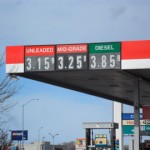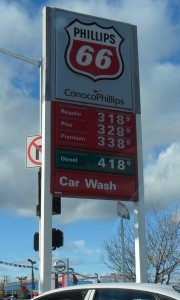Reports out of Los Angeles, California, gasoline prices more than $4.00 USD per gallon (more than $1.00 per liter). A 23 cents jump in one week!
In the southeastern Idaho city of Pocatello, gasoline prices have gone up about 25 cents in the past two weeks. Prices for the more efficient Diesel fuel are about to break the $4.00 mark, but are actually unchanged for the past two weeks.
- A Pocatello, Idaho, gas station today 03 February 2013.
- Pic of the same gas station a week ago. And the week prior low octane gas was less than $3.00. Note the price of Diesel is unchanged.
Once again we can’t blame U.S. oil prices, they’re still under $100 per barrel.
The last time I looked into seemingly unexplained fuel price increases it turned out it was a matter of fuel refined in the western half of the country being shipped off to the more populous eastern half to take up the slack caused by their fuel shortage.
The result was fuel prices stayed lower in the eastern half of the country, but went up for us westerners because our supplies went down! (in the case of California, they had too many refineries down, and their fuel laws make it almost impossible to import refined fuels from out of state)
According to the latest data from the U.S. Energy Information Agency (USEIA) total weekly refined gasoline (Total Motor Gasoline) stockpiles, for the whole country, are up from December, by about ten thousand barrels! As well, total weekly stockpiles of DSO (Diesel) are up from December, by more than 10,000 barrels!
Aw, let’s break it down into the separate Petroleum Administration for Defense Districts (PADD).
I checked PADD 4 (aka Rocky Mountain PADD, serves my area) and discovered that Total Motor Gasoline weekly stockpiles are down from December by 570 barrels. Distillate Fuel Oil (DSO/Diesel) stockpiles down by 143 barrels. So supply has gone down for the Rocky Mountain area.
PADD 5 (West Coast) shows an increase in weekly stockpiles for both gasoline and Diesel.
PADD 3 (Gulf [of Mexico] Coast) also shows an increase in stockpiles of gas and Diesel. The same for PADD 2 (Midwest), as well as PADD 1 (East Coast).
Is a decrease in stockpiles in PADD 4 the cause of price increases across the country, while all other PADDs show increases in stockpiles?
Is it demand? According to a recent report out of California, demand for fuel was down (again) for the third quarter of 2012. That claim is based on California fuel tax collections.
However, the USEIA says overall demand for gasoline, across the country, is up from the same time last year. For 27 January 2012 demand was at 8.018 million barrels per day (MBpD). As of 25 January 2013 demand was at 8.501 MBpD. When you’re talking about MBpD that nearly 0.5 increase is a lot.
Now lets look at demand for Diesel. There should be no reason for Diesel prices to be going up, because the USEIA data shows a slight drop in demand from the same time last year. On 27 January 2012 demand was at 3.73 MBpD, while data for 25 January 2013 shows demand was at 3.72 MBpD.
So far I can’t find a reason for increasing gas and Diesel prices. Overall demand is up for gas, but so is overall supply! Diesel prices should be going down, because overall demand is almost unchanged from last year, and overall supply is up from the month prior! (PADD 4 supply is down, and I couldn’t find any USEIA demand data by PADD)
Regarding PADD 4 area. Although prices are going up, they’re still considered the lowest on average for the whole United States.
Here’s another possibility for fuel prices going up: In mid January a lot of U.S. refineries announced they were closing down for maintenance. Perhaps the price increase is the result of fuel suppliers anticipating the reduced output from shut down refineries?
The following refinery shutdowns were reported back in January by Dow Jones Newswire: Texas City, Texas. Port Arthur, Texas. Borger, Texas. Martinez, California. Wilmington, California. Los Angeles, California. Carson, California. El Segundo, California. Richmond, California. (remember what I said about California fuel regulations? so many refineries down without being able to ship in more fuel from out-o-state) Kapolei, Hawaii. Trainer, Pennsylvania.
Warning for Californians: Phillips 66 is considering selling off its two California refineries! They blame increasing regulation by the Golden State, which is driving up the costs of operations. Currently Phillips 66 is the only U.S. oil company with refineries in all 5 PADD areas. British Petroleum (BP) is also selling off a California refinery, along with the ARCO brand and a refinery in Texas.


